
| KIT #: | 4669 |
| PRICE: | @ 20 Euros |
| DECALS: | One option |
| REVIEWER: | Fernando Rolandelli |
| NOTES: |

| HISTORY |
F-16C BLOCK 52 + JASZTRAB, “4075”, 10th Eskadra “Dragon”
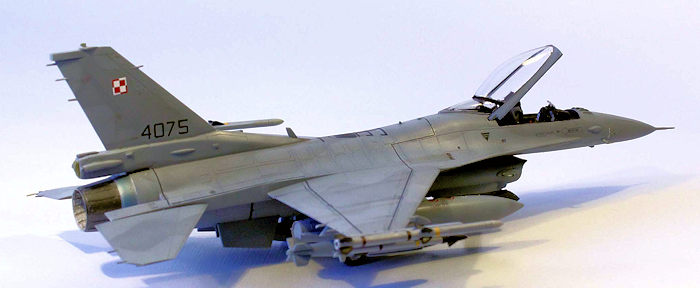 Poland joining NATO in 1999, the task of modernizing its ageing air
force and gaining a degree of interoperability became paramount. As a stop-gap,
the MiG-29 fleet was upgraded and reinforced with ex-Luftwaffe machines. But the
final decision on a definitive fighter aircraft fell on the F-16. Poland
preferred buying new aircraft to second hand or leasing ones. Therefore, on 2003
a contract was signed with Lockheed Martin for 48 (36 C and 12 D) newly built
machines, under the name “Peace Sky”
Poland joining NATO in 1999, the task of modernizing its ageing air
force and gaining a degree of interoperability became paramount. As a stop-gap,
the MiG-29 fleet was upgraded and reinforced with ex-Luftwaffe machines. But the
final decision on a definitive fighter aircraft fell on the F-16. Poland
preferred buying new aircraft to second hand or leasing ones. Therefore, on 2003
a contract was signed with Lockheed Martin for 48 (36 C and 12 D) newly built
machines, under the name “Peace Sky”
Polish F-16s, named Jasztrabs (the name of an indigenous fighter design from the late 30s) are legitimate Block 52+ aircrafts, rather than upgraded ones, powered by Pratt and Whitney F-100-229 engine. The aircraft will be fitted with the latest avionics available, including the APG-68(V)9 radar which provides high-resolution ground imaging, enabling day/night all-weather, precision weapons delivery and the ALQ-211(V)4 electronic warfare suite. A unique recce pod was developed, the Goodrich DB-110, in use in 10th Sqn
| THE KIT |
This is the well-known and very decent Revell F-16, in its “Tiger Meet F-16CJ” incarnation. A good kit, it still holds the line as an AM/BM (and consequently as a D), but has been rendered obsolete as a C by the recent Tamiya kit. That said, the Tamiya is exclusively catered for a F-16CJ Block 50 in present-day USAF service; though flawlessly spot on for depicting one such an aircraft, some amount of surgery should be done for anything else.
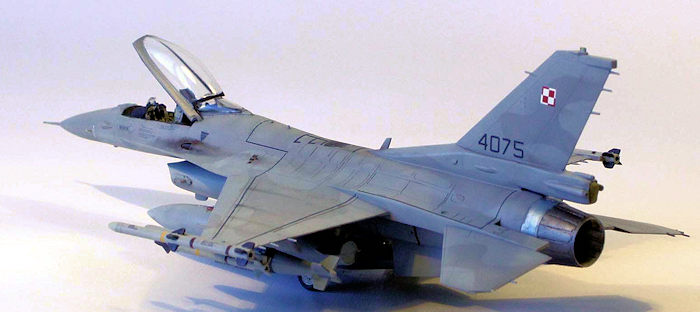 In this case, what you get is an almost complete A kit, together to the
add-on armament sprue, plus a whole sprue with C specific parts. So you get the
two intake/exhaust combos (P&W -NSI, GE –MICD –the exhaust has an intention at
detailing the inner surface) allowing you to build both a Block 40-50 as well as
a 32-42-52. The add-on provides four AIM-120Cs (the cropped winglets ones;
surely an oversight at the time the kit was issued, now they are being seen more
often) plus the LAU-29 launchers. The C specific sprue comes with the larger
mainwheels (but no heavy duty u/c nor bulged doors; main wide wheels are
provided but inexplicably the front one is not), the LEF antennae and a two-vent
gun muzzle. It has a good external load provision: a very accurate HTS pod and
two associated AGM-88 with launchers; a good AN/ALQ-131; two GBU-24; while two
acceptable AIM-9L/M are in the A sprues. All in all, the kit seems more
appropriate for a late-model “A” than a true “C” Viper.
In this case, what you get is an almost complete A kit, together to the
add-on armament sprue, plus a whole sprue with C specific parts. So you get the
two intake/exhaust combos (P&W -NSI, GE –MICD –the exhaust has an intention at
detailing the inner surface) allowing you to build both a Block 40-50 as well as
a 32-42-52. The add-on provides four AIM-120Cs (the cropped winglets ones;
surely an oversight at the time the kit was issued, now they are being seen more
often) plus the LAU-29 launchers. The C specific sprue comes with the larger
mainwheels (but no heavy duty u/c nor bulged doors; main wide wheels are
provided but inexplicably the front one is not), the LEF antennae and a two-vent
gun muzzle. It has a good external load provision: a very accurate HTS pod and
two associated AGM-88 with launchers; a good AN/ALQ-131; two GBU-24; while two
acceptable AIM-9L/M are in the A sprues. All in all, the kit seems more
appropriate for a late-model “A” than a true “C” Viper.
To proceed to the conversion into a Jasztrab, I had the Two Bobs decal sheet. I also tossed in an Eduard Zoom and a Rob Taurus vac canopy (entirely unnecessary –see below). Bulged main u/c doors from The Attack Squadron were also used.
| CONSTRUCTION |
The first step was converting the fin, to the “extended tail”
configuration. For that I used the extension already provided in the A sprue,
widening it to fit the C fin base, from where the “short tail” had been
previously hacked away. Something of a butchery, but successful in the end. The
ASPIS antennae were scratchbuilt. The kit’s rear fuselage is an A-type; Revell
simply having you glue the wider C-type fin base onto the thinner “bed”,
actually covering it and obliterating a couple of panels. Sounds primitive, but
it 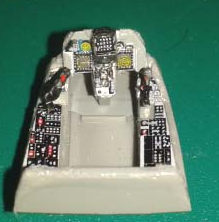 works (I rescribed a few panel lines). Cockpit was furnished with PE parts
and some scratchbuilt sidewall detail. Front and rear fuselage were assembled
without incident. I decided to work a bit on the intake, covering the internal
joints with a coat of Milliput and putty. After some frantic sanding, it worked.
Beware that the fragile front leg should be glued at this early instance (and
cared for during the rest of the construction) The complete, painted unit was
then presented to the rest of the fuselage. The main wheel-well is moderately
d
works (I rescribed a few panel lines). Cockpit was furnished with PE parts
and some scratchbuilt sidewall detail. Front and rear fuselage were assembled
without incident. I decided to work a bit on the intake, covering the internal
joints with a coat of Milliput and putty. After some frantic sanding, it worked.
Beware that the fragile front leg should be glued at this early instance (and
cared for during the rest of the construction) The complete, painted unit was
then presented to the rest of the fuselage. The main wheel-well is moderately
d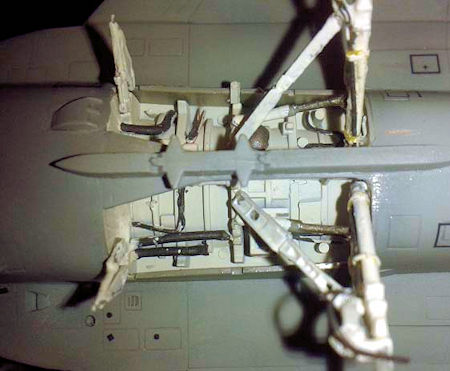 etailed, and received some piping; so the front one. The LEFs, though
“scissor”-designed (so that they fit over and below the leading edge) had to be
laboriously trimmed, glued, puttied and sanded (they didn’t consider the wing’s
thickness!). I selected the plain middle pylons and the LAU-29-equipped outers.
I used the Rob Taurus vac canopy; not because the one in the kit was bad, but
because in some A boxings it comes with a silly Yellowish tinge and should
therefore be replaced (Revell customer service could not be persuaded to provide
replacements); I just wanted to test it. It goes fine; though a bit short, if
posed open you cannot notice. As always (for me, at least), tinting it in the
correct Smoke was a chore: I dared go heavy on the fixed part, and less so on
the big opening hood. I replaced the front wheel for a wide one from a CMK resin
set (not because I had planned to do so, but I lost the original part)
etailed, and received some piping; so the front one. The LEFs, though
“scissor”-designed (so that they fit over and below the leading edge) had to be
laboriously trimmed, glued, puttied and sanded (they didn’t consider the wing’s
thickness!). I selected the plain middle pylons and the LAU-29-equipped outers.
I used the Rob Taurus vac canopy; not because the one in the kit was bad, but
because in some A boxings it comes with a silly Yellowish tinge and should
therefore be replaced (Revell customer service could not be persuaded to provide
replacements); I just wanted to test it. It goes fine; though a bit short, if
posed open you cannot notice. As always (for me, at least), tinting it in the
correct Smoke was a chore: I dared go heavy on the fixed part, and less so on
the big opening hood. I replaced the front wheel for a wide one from a CMK resin
set (not because I had planned to do so, but I lost the original part)
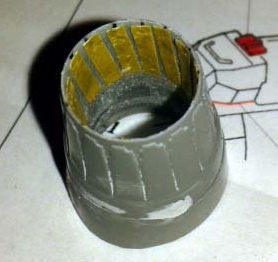 The exhaust was given Tamiya tape “petals”, painted White and weathered.
The exterior was painted in Aluminum and Magnesium from Alclad, and given a
shade of Tamiya Clear Blue for the typical “hot” look. The visible “rings” are
not depicted. It was masked and the “bucket” was presented and glued to the rear
fuselage. It fitted reasonably well.
The exhaust was given Tamiya tape “petals”, painted White and weathered.
The exterior was painted in Aluminum and Magnesium from Alclad, and given a
shade of Tamiya Clear Blue for the typical “hot” look. The visible “rings” are
not depicted. It was masked and the “bucket” was presented and glued to the rear
fuselage. It fitted reasonably well.
Everything mated fairly well with only smudges of putty here and there on the airframe.
Polish Jasztrabs are CFT-capable, but they are as often seen without them. They also use both the big and the normal external fuel tanks; therefore, I used what I had at hand. Usable as the included GBUs were, I chose to arm it with a pair of GBU-39 JDAM GPS guided bombs, which are in use by the Poles. They also use the AIM-120 but their SRAAM is the AIM-9X. I stole a pair from a Tamiya kit. I added a Sniper XR from a left-over Skunk Models sprue, on a Hasegawa pylon (Skunk’s Sniper is a brave multipiece thing with clear window, while both Hasegawa and Tamiya provides single piece stores –the latter in clear plastic. I added the laser unit to the inside). It must be said that most Jasztrabs are seen with just a training -9X round as sole load.
| COLORS & MARKINGS |
As is my use, I gave the model a coat of Alclad Grey primer and a
preshade. Painting was done with Xtracrylix colours: a general FS36375 overall
coat, in an uneven fashion, then some mottling in a lighter shade; over that,
Blue-Tack masking and then FS 36270. To mimick the heavier “demarcation lines”,
seen in the real aircraft, I simply went heavier against the masks; it worked in
a subtle way. Instructions have you paint the radome in 36118, but pictures show
only the subtlest of a darker shade; I mixed some 36251 in th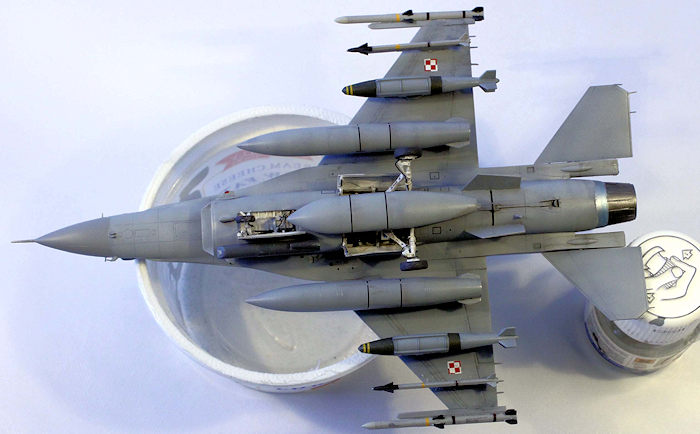 e 36270. Xtracrilyxs Clear was brush applied; an airbrushed artist’s water-base matte
varnish was the final coat. General weathering was given with MiG Grime Streak
and pastels. Polish Jasztrabs are invariably pristine, but now that they will be
deployed overseas, matters will surely look different.
e 36270. Xtracrilyxs Clear was brush applied; an airbrushed artist’s water-base matte
varnish was the final coat. General weathering was given with MiG Grime Streak
and pastels. Polish Jasztrabs are invariably pristine, but now that they will be
deployed overseas, matters will surely look different.
Two Bobs’ decals are very good. They come with a complete set of stencils, which is a bonus; in this machines they are Black, so “normal” ones wouldn’t work. They showed some oddities, though: the walkway lines are so thin and carrier-less that putting them straight is a chore. The Polish traditional checkers are two part, a White square and then the Red checker (against clear film); well, the White squares are handed! Yep, handed: they are larger in the checker square that should show White edging (curiously, the one in Red… look at one and you’ll understand) The refueling receptacle decal was too big for the one inscribed in the kit, and the paint on it had to be retouched. Decals for the missiles came from assorted stencil leftovers and are therefore spurious, but the bands were painted.
| CONCLUSIONS |
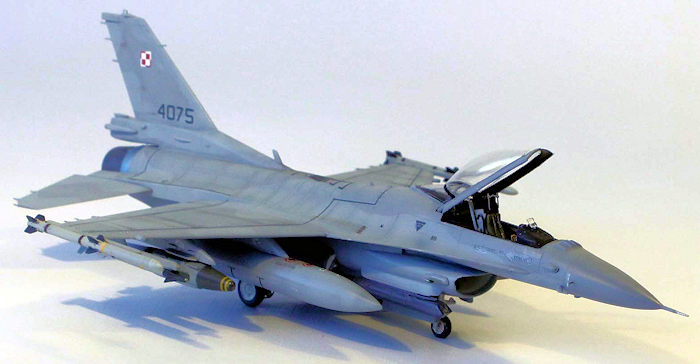 Revell’s F-16s are nice, well behaved kits. If built OOB, with little or
no pretense, they are among the sweetest you can find. Working them up is a bit
of a job, but a good result can be attained. Undercarriage is still an issue; I
am about to sell myself to the “one piece main gear” style found on Tamiya’s
(and, curiously, Kinetic’s). They can be thoroughly recommended.
Revell’s F-16s are nice, well behaved kits. If built OOB, with little or
no pretense, they are among the sweetest you can find. Working them up is a bit
of a job, but a good result can be attained. Undercarriage is still an issue; I
am about to sell myself to the “one piece main gear” style found on Tamiya’s
(and, curiously, Kinetic’s). They can be thoroughly recommended.
| REFERENCES |
- F-16.net
- “Uncovering the F-16”, Daco Productions
- “F-16 In Action”, Squadron Signal Publications
- JBaugher internet site.
29 November 2016
Copyright ModelingMadness.com If you would like your product reviewed fairly and fairly quickly, please
contact
the editor or see other details in the
Note to
Contributors. Back to the Main Page Back to the Review
Index Page
Back to the Previews Index Page